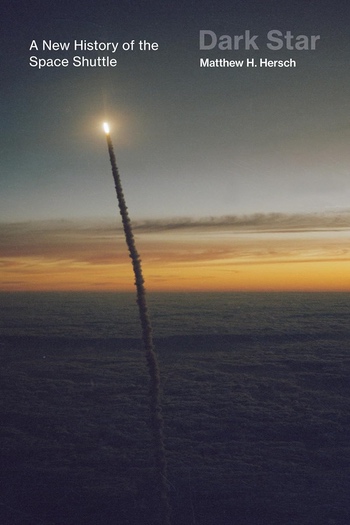Review: Dark Starby Jeff Foust
|
| The theme of the book is to put that history into a context of long-running efforts to develop spaceplanes that, to their advocates, seemed like a natural extension of aviation. |
Dream Chaser is a reminder that the vision of a spaceplane, offering airplane-like access to space, lives on despite the failures of past efforts. The biggest such effort, of course, was NASA’s Space Shuttle, a technological marvel but one that failed on its stated goals of providing frequent, low-cost access to space. That failure demonstrated the futility of the spaceplane concept in general, argues historian Matthew Hersch in his book about the shuttle, Dark Star.
Billed as a “new history” of the shuttle, the book offers little in the way of new information about the shuttle program, relying on a mix of primary and secondary sources. Instead, the theme of the book is to put that history into a context of long-running efforts to develop spaceplanes that, to their advocates, seemed like a natural extension of aviation.
That history goes back 40 years before STS-1, when Eugen Sänger and Irene Bredt proposed the Silbervogel, a suborbital rocketplane that would have allowed Nazi Germany to bomb the United States. It was never built (and had it been, Hersch notes, the vehicle would not have survived its first flight because erroneous calculations underestimated the heating it would experience) but it set in motion American post-war interest in rocket-powered aircraft that could reach space. While the X-15 set altitude and speed records, true orbital spaceplanes failed to take off, with projects like the X-20 Dyna-Soar cancelled. Interest in spaceplanes was fading in the 1960s with the focus on expendable rockets and capsules during the race to the Moon.
Its prospects were revived when NASA started pursuing what would become the shuttle. Its development, though, was affected by competing demands and design compromises familiar to most readers that turned it, he writes, “from an optimistic effort to create a spacefaring civilization to an awkward, winged vehicle that satisfied no one.” Yet its vision of enabling low-cost routine access to space—“a comfortable spaceflight experience even for the lay public”—persisted even as the shuttle failed to deliver on it.
The book speeds through the actual flight history of the shuttle, including the Challenger and Columbia accidents. He offers a contrarian take on the widely held view that “normalization of deviance,” as Diane Vaughan famously described the underlying cause of Challenger (and which resurfaced after Columbia) was to blame for those accidents; he describes that as “a symptom rather than the cause of the shuttle’s difficulties,” which were rooted in its technical flaws. The shuttle flew for three decades despite those flaws, he concludes, because the efforts to develop alternatives never panned out.
| Certainly nothing like the shuttle is likely to be developed again, but there remains not just interest but actual flying spaceplanes today. |
“The shuttle was simply built the wrong way, at the wrong time, and for the wrong reasons,” he writes, a blunt but hardly surprising conclusion. The title of the book is taken from the darkly comedic sci-fi movie of the same name from 50 years ago about a ship plodding through the cosmos to discover—and blow up—other worlds. The shuttle’s development, Hirsch writes, “reflected Dark Star’s ambivalence of purpose, flirtation with routine, and hints of danger.”
“Although interest in winged space vehicles remained after the end of the shuttle program, the unique set of circumstance that produced the space shuttle of 1972 are not likely to rise again anytime soon,” he states near the end of the book. Certainly nothing like the shuttle is likely to be developed again, but there remains not just interest but actual flying spaceplanes today, something the book largely overlooks. There are two spaceplanes in orbit now—the US Space Force’s X-37B and a Chinese counterpart—that are uncrewed 21st century versions of the X-20 Dyna-Soar, carrying out largely classified missions. Virgin Galactic is flying its suborbital VSS Unity spaceplane for private astronaut flights, although it will soon retire Unity to focus on development of a new “Delta-class” vehicle that promises, like so many before it, less expensive and more frequent access to (the edge of) space.
And there is the aptly named Dream Chaser, going through thermal vacuum tests at that Ohio facility named after a man who once flew the X-15 rocketplane. Despite past failures by the shuttle and other vehicles, it is hard for people to give up on the dream of the spaceplane.
Note: we are now moderating comments. There will be a delay in posting comments and no guarantee that all submitted comments will be posted.
